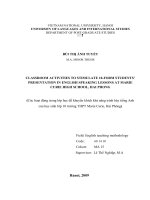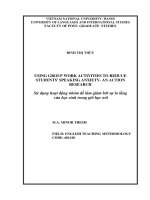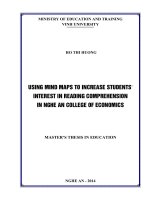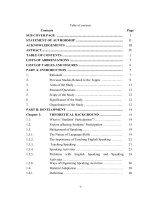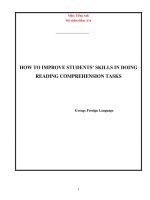Some activities to stimulate students’ speaking in speaking lessons (tiếng anh 10)
Bạn đang xem bản rút gọn của tài liệu. Xem và tải ngay bản đầy đủ của tài liệu tại đây (1.3 MB, 21 trang )
Table of contents
Contents
Name of the theme
A.Introduction
Page
2-3
I. Reasons of choosing the theme
II.Purposes of the study
III. Scopes of the study
IV. Research methodology
B- Contents of the theme
I.Theoretical basis
II.Practical basis
3-14
III.Applying some activities to stimulate students' speaking
IV.Results
C.conclusion
1. Conclusion .
2.Suggestion
Reference books
Appendix
14-15
16
17-21
A. INTRODUCTION
I.THE REASONS OF CHOOSING THE THEME
According to my teaching experience, four language skills –
listening, speaking, reading, and writing should be fully stimulated during the
course of study to help the students communicate in the target language since the
lack of any skills will spoil the effectiveness of communication. However,
1
learning quality is still far from being satisfactory. Learners have faced many
difficulties in English learning, especially in the learning of speaking skills.
In fact, it is undeniable that many Vietnamese students after seven years
learning English at schools still feel confused when communicating with
foreigners or they even could not say a simple utterance like an offer. Obviously,
the ability to communicate in a foreign language clearly and effectively
contributes to the success of the learner in school and success later in every
phase of life.
Like many high schools in Vietnam,at Quang Xuong 3 high school,
English has been a compulsory subject in its curriculum for many years and the
English speaking skill is one of five official parts in a unit. However, due to the
demand of the high school graduation exam, which means little attention has
been paid to the speaking skill. Sometimes, they feel bored with the difficult and
uninteresting topics in the textbook ‘Tieng Anh 10’. With 6 year – experience in
Quang Xuong 3 school.HS,I find that the English lessons with speaking
activities designed by teachers always motivate students and get them involved
in speaking effectively.
The effort of this thesis is trying to encourage teachers to apply innovative
methods in teaching speaking skill for learners and to help students to learn
speaking subject more effectively. Having students work in groups not only
makes them more involved in learning but also gives the m opportunities to
practise the foreign language being learned. There are many reasons but above
are the main drivers for us to engage in this study entitled Some activities to
stimulate students' speaking in speaking lessons (Tieng anh 10)
II. Purposes of the study
The study is aimed at:
- Investigating the situation of teaching and learning speaking to 10th
Graders in Quang Xuong 3 High School, Quang Xuong, Thanh Hoa;
- Investigating the effectiveness in Some activities to stimulate students'
speaking in speaking lessons (Tieng anh 10)
III.Scope of the study
This study is implemented to find answers to the following research
questions:
1.
What are students’ difficulties in learning the current English speaking
activities in ‘Tieng Anh 10’?
2
2.
Which speaking lessons (in 16 units of Tieng Anh 10) are difficult for
the students at QX3HS?
3.
What speaking activities in the textbook “Tieng Anh 10”should be
adapted to reduce students’ difficulties?
IV.Research methodology
To achieve the aims mentioned above, the study employed survey
questionnaire for students, interview for teachers and classroom observations
to collect information on the the students’ difficulties and seeks a way to reduce
those difficulties by adapting some unsuitable textbook pre-designed English
speaking activities in “Tieng Anh 10”.
•
•
•
•
•
•
B. CONTENTS OF THE THEME
I. Theoretical basis
In reality, a textbook can never totally be an effective tool for teachers to
follow without any adaptation because of its intrinsic deficiencies such as
linguistic inaccuracies, out-of-datedness, lack of authenticity or lack of variety.
Thus, I favor Madsen and Bowen’s (1978) and Tice’s (1991) view that is the
purpose of material adaptation is to compensate for those deficiencies. This is
important to all teachers of English because it can activate learners and stimulate
their motivation, and increased motivation, in turn, is likely to create a more
conductive classroom atmosphere.
II.Practical basis
1. Problems with English speaking
Everything has bad and good sides. Speaking also has its own problems.
According to Brown (1994: 256), the characteristics of spoken language can
make oral performance easy as well as in soe cases difficult. There are following
problems with speaking:
Clustering
* Redundancy
Reduced forms
* Colloquial language
Stress, rhythm and intonation
* Affective factors
Interaction
2. Problems with English speaking activities
It is more difficult to design and adminster such activities than to do so for
listening, reading or writing. Teachers often come across the problems that Ur
(1996:121) lists out:
Inhibition
* Nothing to say:
Lows or uneven participation
* Mother-tongue use:
Basing on these views, an action research is to caried out on adapting
some English speaking activities for the ‘Tieng Anh 10’ to reduce these
difficulties.
3.Applying some activities to stimulate students'speaking
3.1. ROLE PLAY
a.Activities 1
Application: Task 3 - Unit 6: An excursion
3
Aims: Giving opinions, expressing agreement and disagreement
Class time: 20 minutes
Materials: English textbook 10, page 66
Source: Section cards and role cards (See Appendix 1)
Procedure:
1. Copy and cut the 4 role cards of each people and the 6 section cards.
2. Divide the class into group of four (or three if there are only three students
left). Give each group one set of role cards and one set of situation cards (for
group of three, leave out role card D)
3. Ask the students to sit round the table with the situations cards face down in a
pile in the middle of the table. The cards should be in order from 1 to 6. Each
student should have a role card 1, 2, 3 or 4.
4. Tell the students that it is Sunday morning and Tim’s class is going on a boat
on Lake Michigan in Chicago. Read the seat plan. You suggest the best seat in
each section for each person.
5. The object of the game is using structures ‘… think …‘should’ or should not…
because’. Or giving opinions via answers ‘Yes’, ‘No’. basing on the content of
textbook ‘Tieng Anh 10’.
6. The game is finished when they have successfully decided on each people’s
seat. Ask groups their decision on some sections and check with the whole class.
b. Activities 2
Application: Task 2 – Unit 3: People’s background
4
1.
2.
3.
4.
5.
Aims: to encourage students to find out information related to their friends’
background for their presentation next task.
Level: Elementary
Class time: 10 minutes
Materials: English textbook 10, page 35
Source: English Textbook 10, Education Press, 2006 (See Appendix 2)
Procedure:
The teacher elicits situation and ask students to make questions basing on
given information, for example:
The teacher introduce some special expression for students to do the natural
conversation.
Students work in pairs to do the interview
Teacher walks around to encourage and help students if necessary
Teacher calls some pairs to do the interview before class.
After doing this task, students can collect information to talk about the friend
they have interviewed for reporting at the end of the lesson. Most students are
eager to do the task because they can do it in role of the interviewers.
3.2. INFORMATION GAP
a. Activities 1
Application: Task 3 – Unit 1: A day in the life of …
Aims: Talking about daily activities.
Class time: 10 minutes
Materials: English textbook 10, page 14
Source: Role cards
Role Cards
Student A
In the
At 10
In the
Before
At the
5
morning
a.m
evenings
bed
weekends
?
?
?
?
?
In the
morning
At 10
a.m
In the
evenings
Before
bed
At the
weekends
?
?
?
?
?
Tom
James
Sara
Partn
er
Student B
Tom
James
Sara
Partn
er
6
The pictures are adapted from
Procedure:
1. Copy the two role cards. They are the same but some information is missing
from each.
2. Ask students to work in pairs. Give each pairs the 2 role cards.
3. Tell the students to complete the form by asking and answering their partner’s
questions.
e.g. A: What does Tom do after school?
B: He often does exercise.
4. Tell the students to write the answers in the boxes or draw the picture.
5. Ask the students to write his/ her partner’s name in the last box and ask him/
her the same questions to complete the boxes.
6. The activity is finished when students have completed all the missing
information. Tell students to stand up and make full sentences about the
characters in the cards.
b. Activities 2
Application: Task 2 – Unit 15: Cities
Aims: Comparing two cities
Class time: 15 minutes
Materials: English textbook 10, page 159
Source: Role cards – Cities (See Appendix 3)
Procedure:
1. Copy the two role cards - cities. They are the same but some information is
missing from each.
2. Ask students to work in pairs. Give each pairs the 2 role cards.
3. Tell the students to complete the form by asking and answering their partner’s
questions.
e.g. When was New York founded?
What is population of New York?
How many national holidays are there in New York?
5. The activity is finished when students have completed all the missing
information in their cards.
6. Ask some students to stand up and talk about the person they have asked their
partners to get the information about their cities.
7
3.3. CO-OPERATIVE LEARNING
a. Activity 1
Application: Task 1 – Unit 5: Technology and You
Aims: Asking for and giving information about the uses of modern inventions.
Class time: 10 minutes
Materials: English textbook 10, page 56
Source: Modern inventions Cards
Modern inventions Cards
Computer
Mouse
Memory card
Printer
Disk drive
Laptop
8
Answering machine
CD player
Computer
Fax machine
Camera
Cell phone
Digital Camera
Microwave
Cassette tape
Clock radio
Dishwasher
Remote Control
The pictures are adapted from: http: www.esl-library.com
1.
2.
3.
4.
5.
6.
Procedure:
Copy and cut out the 18 modern invention cards above
Divide the class into groups of six (or five if there are only five students
left). Give each group one set of job cards.
Tell the students to put cards face down on the table
Ask students to take it turn to pick up a card and ask and answer about the
uses of modern inventions. Put some helpful language on the board for them to
refer to:
A: Can/ Could you tell me what ……………………… is used for?
B: It is used to ……………………………………………………....
The activity is finished when each student has said at least one thing about each of
the cards.
Ask one group to stand up and say about one of the modern inventions in
the cards. Ask the other groups to add more information.
b. Activity 2
Application: Task 2 – Unit 11: National Parks
Aims: Expressing regrets. (using the conditional sentence type 3)
Class time: 15 minutes
Materials: English textbook 10, page 115
Source: Situation cards - List of wishes (See Appendix 4)
Procedure:
9
1.
2.
Copy the list of wishes and the situation cards, cut out the situation cards
Divide the class into groups of six (or five if there are only five students
left). Give each student a list of wishes and two situation cards .
3.
Tell the students to complete their list of wishes by saying according to
model others in their group:
e.g. If we had not …., we wouldn’t have …
4.
When students have completed all the missing information in their list of
wishes, ask them to tell their group the most interesting or surprising wisher they
have known.
3.4. DISCUSSION
a. Activity 1
Application: Task 3 – Unit 8: The story of my village
10
1.
2.
3.
4.
5.
1.
2.
3.
Aims: Talking about plans and possible results (in the village).
Class time: 10 minutes
Materials: English textbook 10, page 85
Source: Question Cards (See Appendix 5)
Procedure:
Copy, cut out and shuffle question cards.
Divide the class into groups of four (or three if there are only three
students left). Give each group one set of question cards
Ask students to sit round the table with the question cards face down in a
pile in the middle of the table. One student starts by turning up the top card,
reading it out to the group and discussing their plans and possible results. The
next student now picks up a card, reads it out … and the activity continues.
Stop the students at the end of the time limit.
Ask each group in turn which question card gave rise to most discussion.
b. Activity 2
Application: Task 3 – Unit 9: Undersea World
Aims: Reporting on discussion results
Class time: 15 minutes
Materials: English textbook 10, page 97
Source: Situation Cards (See Appendix 6)
Procedure:
Copy and cut out the 5 situation cards.
Divide the class into groups of four (or three if there are only three
students left). Give each group one set of situation cards
Ask students to turn up the first card and compare four situations on the
card to find out solutions. Encourage them use ‘should’ and ask groups
exchange situations, then discuss again.
11
4.
1.
2.
3.
4.
When the time is over, find out the best solutions.
c. Activity 3
Application: Task 2 – Unit 14: The World Cup
Aims: Asking and answering questions about the World Cups
Class time: 20 minutes
Source: Handouts (See Appendix 7)
Procedure:
Copy handouts.
Divide the class into groups of six (or five if there are only five students left).
Give each group two handouts
Tell students to complete their handouts by asking and answering the others in
their group such as:
A: Where was the first World Cup held?
B: It was held in Uruguay.
A: Which teams played in the final match?
B: Uraguay and Argentina.
A: Which team became the champion?
B: Uraguay
A: What was the score of the match?
B: 4 - 2
When students have completed all the missing information in their handouts, ask
them add more information about famous football team if they know.
12
1.
2.
3.
4.
3.5. INTERVIEWS
Application: Task 2 – Unit 4: Special Education
Aims: Making an interview.
Class time: 20 minutes
Materials: English textbook 10, page 48
Source: Handouts (See Appendix 8)
Procedure:
Copy and cut out the six handouts.
Divide the class into groups of six (or five if there are only five students
left). Give each student one of the six handouts.
Explain that each student has some questions in their handout, ask them to
interview four other people in their group and make a note of answer they get.
Stop the students at the end of the time limit whether they have finished
or not. Ask some students to stand up and present their work.
4. Results
In order to assess the effectiveness of applying this method to teaching
reading, I have compared my work with many classes (10D, 10A5, 10 A2 school
year 2013-2014, 10 D, 10 A2, 10A3 school year 2014-2015) for many years.
Before using this method, most of my students find it difficult to complete all
the taks in the text book.
It is a matter of fact that after applying Some activities to stimulate
students' speaking in speaking lessons (Tieng anh 10) , my students and I felt it
very interesting , they seemed to be very eager for speaking lessons. During the
lessons, all the students were involved in the activities. After each speaking
13
lesson, students remember the speaking situation more thoroughly. Besides, they
had many chances to practice many other skills like writing and listening,
especially speaking in pairs, in groups or in individually in front of the whole
class
Chart . Students’ feedback towards applying changing or
adding English speaking activities and their effectiveness.
Most children love to speak English with the following results:
Good
Quite good
Medium
Quite bad
Beginning of the year
10%
12%
40%
28%
After 1st term
20%
28%
32%
20%
After 2nd term
34%
32%
20%
14%
C- CONCLUSION
1. Conclusion
Teaching method is a product connecting theory and practice in order to
help students get knowledge, practice their skills and solve the problems.
Changing teaching method, according to me, is changing the role of the teacher
from the provider into a consultant; students will fulfil the demand of knowledge
themselves. It is clearly that in my class, with some activities desiged by me, the
atmosphere of learing is getting more and more exciting, students are voluntary
participants in teaching process, I myself find it is relaxing to be a guide instead
of being a translator, for all the activities in the classroom.
2. Suggestion
Basing on practical teaching English text book 10, 11, 12 Education
Publishing House, I suggest :
First, the communicative activities presented in some tasks in speaking
lesson in ‘Tieng Anh 10’ are not effective because they are not varied and
interesting enough to attract the students’ concentration or some topics are not
familiar to them due to the low background knowledge of rural students,
generally. Therefore, to motivate students in speaking lessons, it is vitally
necessary to adapt these speaking activities.
Secondly, the students’ favorite speaking activities except for games are
also highly appreciated by the teachers. Moreover, these activities get them not
bored and make them more confident. However, games are not always profitable
and very time-consuming though they are very interesting and attract students’
attention.
14
This is my little experience in finding methods to help students find
speaking lesson more interesting . I hope to receive your reading and comments
as well as contribution to make this theme more perfect so that it can be applied
widely.
Validation, evaludation,classification
Of the school.
…………………………………………
………………………………………….
………………………………………….
………………………………………….
…………………………………………
HEAD MASTER
(sign,affix)
Sam Son,April 17th,2016
I assure that the writing above is
mine,not copying.
( sign and write your full name)
Nguyen Thi Khue
15
REFERENCE BOOKS.
1. Bailey, K.M. and Savage, L. (1994). New Ways in Teaching Speaking.USA.
2. Byrne, D. (1991). Teaching Oral English. Longman.
3. Hadfield, J. (1985). Elementary Communication Games. Thomas Nelson and
Sons Ltd.
4. Hoa, H.X., et al (2004). Tài Liệu Bồi Dưỡng Giáo Viên Dạy Sách Khoa Lớp 10
– Môn Tiếng Anh. The Ministry of Education and Training.
5. Jones, L. (2002). Let’s Talk 2: Teacher Support Site. Cambrigde University
Press.
6. Ellis, M. (1986: 47). Making and shaping games. How to adapt. University of
Technology, Loughborough.
7. Madsen, K.S., &Bowen, J.D. (1978). Adaptation in Language Teaching.
Rowley, MA: Newbury House.
8. Nunan, D. (1989). Designing Tasks for the Communicative Classroom.
Cambrigde University Press.
9. Van, H.V., et al (2006). Tiếng Anh 10. Education Publishing House of Vietnam.
10.Wallwork, A. (1994). Discussions A-Z Advanced: A Resourse Book of Speaking
Activities. Cambrigde University Press.
11. Watcyn-Jones, P. (1995). Grammar Games and Activities for Teachers. Penguin
Books.
Websites:
APPENDIX
16
APPENDIX 1
Section cards: Tim’s class is going on a boat on Lake Michigan in Chicago.
Read the seat plan. You suggest the best seat in each section for each person.
1. Mrs. Andrew. Which section?
Why?
4. Tim. Which section? Why?
2. Susan. Which section? Why?
5. John. Which section? Why?
3. Mary. Which section? Why?
6. Sam. Which section? Why?
Role – cards.
1.
Mrs. Andrews would like to 2.
Susan would like to near Mary.
see all the students
She don’t want to get sunburst
She doesn’t want to sit on the sun
deck
3.
Mary would like to plenty of 4.
Tim would like to sit in the sun
fresh air.
and he wants to be himself
She doesn’t want to suffer from
traffic sickness
5.
John would like to take
photographs
He doesn’t like air- conditioning
Susan would like to have a good
view
Adapted from ‘Elementary Communication Games’ by Jill Hadfield (1985)
APPENDIX 2
Role cards
-
1. Questions:
When were you born?
Where were you
born?
What is your address?
Could you tell me about your parents? What does your father/mother do?
How many brother do you have?/What do you do?/ How old are
2. Expression to do the natural
conversation:
school?
Hello. I’m Lan
Hello. Nice to meet you!
How nice to see you!
Since when have you studied at this
Could you tell me something about
your parents?
17
Let me see …
Which primary school did Oh, good! Oh, yes! Oh, come on!
you go to?
I think it’s time to stop. Thanks a lot
Which secondary school Thank you for giving me time.
did you go to?
Thank you very much. That was
How do you work at
very interesting
school? Do you join all school
activities?
What is your favorite
subject?/ What subject do you like
best?
-
they?
Role cards - Cities
Student A
APPENDIX 3
New York
Found
Population
Area
National holidays
High buildings
Park
People
Transport
1624
7 million
946 square km
7 days
many
One
friendly, open
convenient
London
43 AD
7 million
Student B
New York
Found
Population
Area
National holidays
High buildings
Park
People
Transport
1624
7 million
London
43 AD
7 million
1610 square km
14 days
Few
Five
Formal, reserved
Convenient
APPENDIX4
Situation cards
1. They went by coach, most of people got car sick
2. They did not bring enough food and drinks; they had to spend a lot of
money eating in expensive restaurant.
3. Some had food poisoning, they didn’t enjoy their visit
4. They had no rain coats, they got wet and some got a cold.
5. Some left their luggage on the coach when they arrived; they had no
18
clothes or money with them.
6. Some were not careful when walking in Huong pagoda, they got lot.
7. Some threw waste in the forest, they got fine.
8. They stayed there only one day, they couldn’t visit all the pagodas.
List of wishes
Name: …………………………………
If they hadn’t …
They wouldn’t have …
gone by coach
brought enough food and drinks
had food poisoning
had no rain coats
left their luggage on the coach when
they arrived
been not careful when walking in
Huong pagoda
thrown waste in the forest
stayed there only one day
Adapted from ‘Let’s talk 2: Teacher support Site’ by Leo Jones (2002)
APPENDIX 5
Question cards
1. In your school, there will be a new library. What should you do then?
2. If there were a new supermarket in their neighborhood, would you buy
anything you want without bargaining?
3. Would you do if there were a new cinema in their neighborhood?
4. In their neighborhood, there will be a new hospital. What should you do
then? Discuss this problem.
Question Cards are adapted from ‘Discussion A-Z Advanced’ by Adrian
Wallwork (1994)
APPENDIX6
Situation Cards
1. Sam Son beach is filled with plastic bags, pieces of class and cigarette
butts
2. Whales and sharks are still hunted for food, medicine, and other products
3. Explosives are used to catch and other sea animals
4. Oil is spilled from tankers
5. Your village is dirty with rubbish
Question Cards are adapted from ‘Discussion A-Z Advanced’ by Adrian
Wallwork (1994)
APPENDIX 7
19
Handout A
Time Years
s
1
1930
3
1938
4
1950
5
1954
8
1966
11
13
1978
1986
15
16
17
1994
1998
2002
Handout B
Time Years
s
1
1930
3
1938
4
1950
5
1954
8
11
1966
1978
13
1986
15
16
17
1994
1998
2002
Winner
Score
Uruguay
Uruguay
Runnerup
Argentina
4
2
3
England
Score
Host
country
2
France
2
West
Germany
England
Argentina
Argentin
a
Brazil
France
Brazil
3
2
0
0
Winner
Score
Brazil
Germany
Runnerup
The USA
0
Score
4
Host
country
Uraguay
Italy
2
West
Germany
Argentin
a
Brazil
Switzerlan
d
Hungary
4
3
2
1
West
Germany
Italy
3
2
Mexico
0
0
France
Korea &
Japan
Adapted from ‘Discussion A-Z Advanced’ by Adrian Wallwork (1994)
APPENDIX 8
Handouts
Interview four other people in your group about their subjects, timetable,
lower-secondary school, tests…
What
Name Name Name Name
……. ……. …….
…….
were your subjects then?
was your timetable?
about your homework?
lower-secondary school didn’t you like
then?
20
part of the school life didn’t you like
then?
do you think about your tests and
exams at your school then?
did you like best about your school
then?
Adapted from ‘Grammar Games and Activities for Teachers’ by Peter WatcynJones (1995)
21
